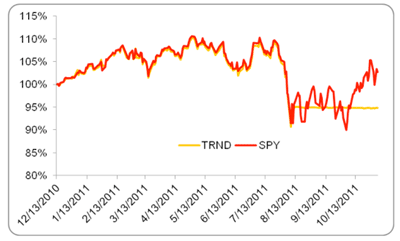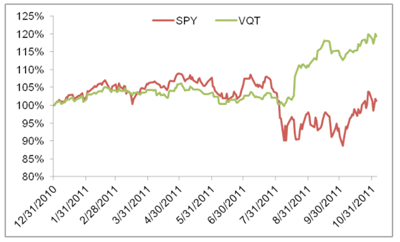Newly developed "dynamic" ETFs have the power and flexibility to shift exposure between various sectors or assets depending on the market environment and do so at low cost to the trader.
The vast majority of the 1,300+ exchange traded products (ETPs) now available to US investors are alike in that they offer static exposure to a specific asset class, whether it be stocks, bonds, commodities, volatility futures, or other "exotic" securities. While the composition of the underlying portfolios changes regularly, the type of exposure offered-be it to soybean futures, large-cap US stocks, or inflation-protected bonds-remains generally stable.
But a number of relatively new exchange-traded products differentiate themselves by offering "dynamic" investment strategies that have the potential to shift allocations between multiple asset classes depending on price trends, volatility, or other observable market conditions.
In other words, these ETPs offer low-maintenance access to investment strategies that call for investors to switch their exposure between different assets depending on the market environment, in many cases providing a "hands-off" solution that would be time consuming and/or expensive to implement independently.
And we're not talking about subtle tilts towards various sectors or futures contracts of varying maturities; the ETPs profiled below have the latitude to shift between assets that offer wildly different risk exposures and expected rates of returns:
Trendpilot ETNs: Oil, Gold, and Stocks
RBS is a relative newcomer to the US ETP industry, but the company has been quickly gaining traction as a pioneer of the "Trendpilot" strategy offered by four of its exchange traded notes (ETNs). These products, which cover various asset classes, implement a relatively straightforward strategy; the underlying indexes oscillate between cash and the relevant exposure type depending on the position of a specified benchmark relative to its historical moving average.
In other words, the Trendpilots are "hands-free" trend following ETNs that shift into cash when the target asset class is deemed to be in a downwards trend and move back into a long position when prices are trending upwards.
Take the RBS US Large-Cap Trendpilot ETN (TRND) as an example. When the S&P 500 Total Return Index is at or above its 200-day simple moving average (SMA) for five consecutive trading sessions, TRND goes long into the S&P.
If the same index closes below its 200-day SMA for five consecutive sessions, exposure shifts into short-term T-bills. The result is a limit to downside losses, which becomes apparent when comparing TRND to the S&P 500 SPDR (SPY) in 2011:
As shown above, TRND essentially moved in lock step with the Spyder Trust (SPY) from December 2010 through August of this year before it switched exposure to cash. That's when TRND flatlines, avoiding the volatility that the more traditional SPY has been experiencing.
Trend-following strategies are, of course, nothing new. They have been around for decades, and are relatively easy for investors to implement on their own. But the combination of these techniques with the exchange traded structure can result in a unique value proposition for certain investors, thanks to a potentially more tax efficient experience and significantly reduced commissions fees.
Trend following ETNs, in other words, eliminate some of the most significant headaches that have plagued investors carrying out similar methodologies on their own.
The current stable of Trendpilot ETNs includes:
- US Large Cap Trendpilot ETN (TRND)
- US Mid Cap Trendpilot ETN (TRNM)
- Gold Trendpilot ETN (TBAR)
- Oil Trendpilot ETN (TWTI)
RBS also offers one additional ETN, the recently-launched Global Big Pharma ETN (DRGS).
NEXT: The New Era of the "ETN+"
|pagebreak|Examining the "ETN+"
Another non-static ETN is the Barclays ETN+ S&P VEQTOR ETN (VQT), a quirky product that has delivered some impressive returns so far this year as a result of its unconventional methodology. Whereas the aforementioned Trendpilot products mix exposure between two potential asset classes, VQT actually has the flexibility to maintain exposure to three: equities (as represented by the S&P 500 Total Return Index), volatility, and cash.
The allocation mechanism behind VQT uses observed market volatility as the primary consideration. During periods of low volatility, the index is invested primarily in equities. When volatility spikes, the allocation shifts towards volatility futures. There is also a "stop loss" function that shifts the entire index into cash equivalents in certain environments.
VQT is unique in that the exposure offered is not "all or nothing." In other words, in many environments the underlying index will consist of exposure to multiple asset classes; currently, VQT includes both volatility and equities. The allocation between these asset classes will depend on both realized volatility and the presence of a volatility uptrend or downtrend, with the equity component generally ranging from 60% to 97.5%.
This methodology may sound a bit complex, but the results turned in so far in 2011 should be pretty easy to understand; the moderate allocation to VIX futures has bolstered the performance of VQT in recent months as volatility has spiked, creating a huge gap between this ETN and SPY:
By Michael Johnston of ETFdb.com























